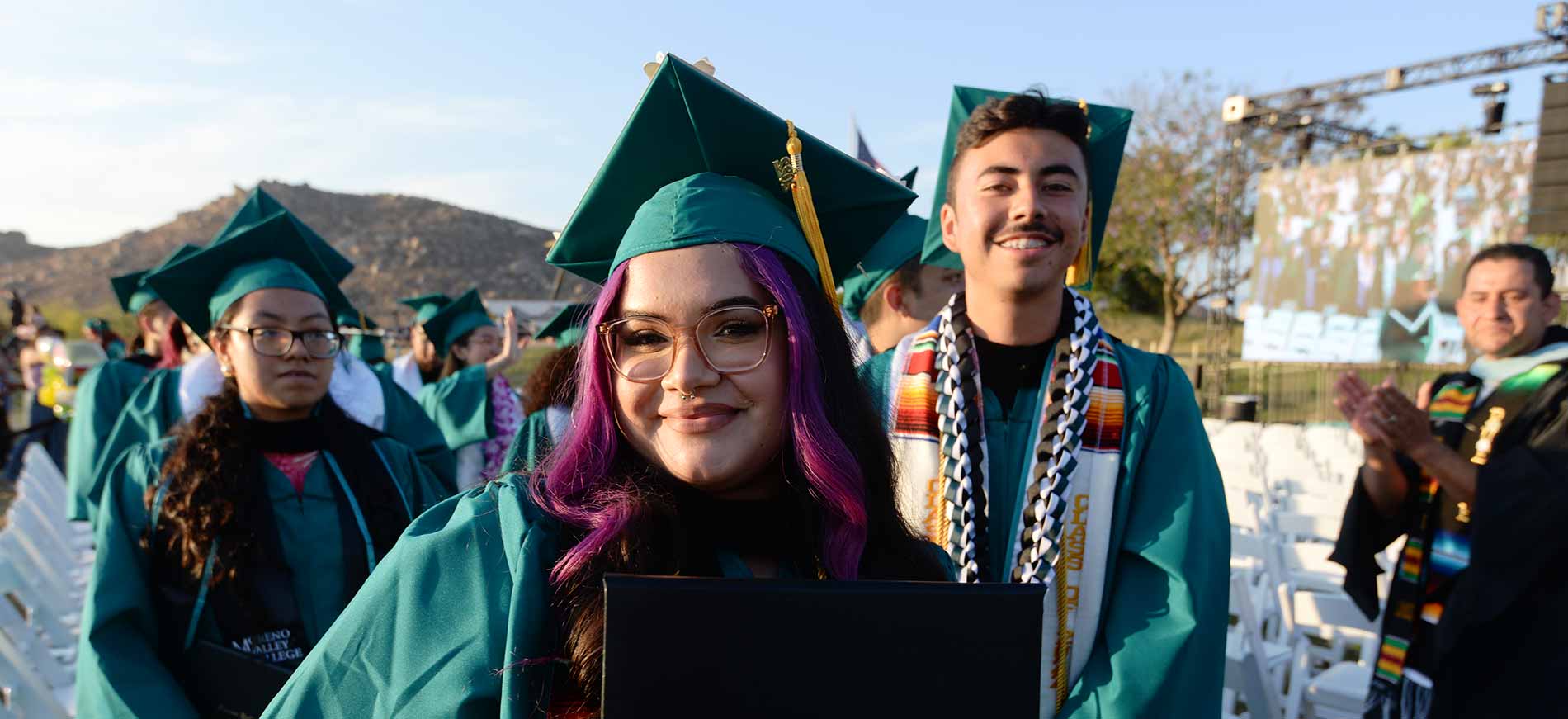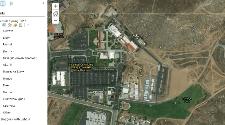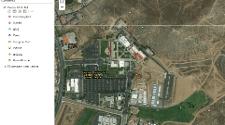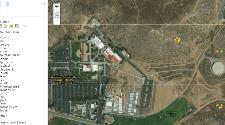Research
Student research methods
The Flying with Swallows (FWS) project at Moreno Valley College (MVC) is conducted along two lines of inquiry: Ecosystem Survey and Ecosystem Investigation. Beyond field research opportunities, several biology and chemistry courses conduct research upon these two lines of inquiry according to curricular requirements and proposed student learning outcomes, which include:
- Experimental skills; independent responsibility; intrinsic motivation.
- Collaborative and communication skills; respect for others
- Problem-solving skills including critical thinking; application of knowledge to formulate questions and hypotheses for research; critically evaluate scientific papers
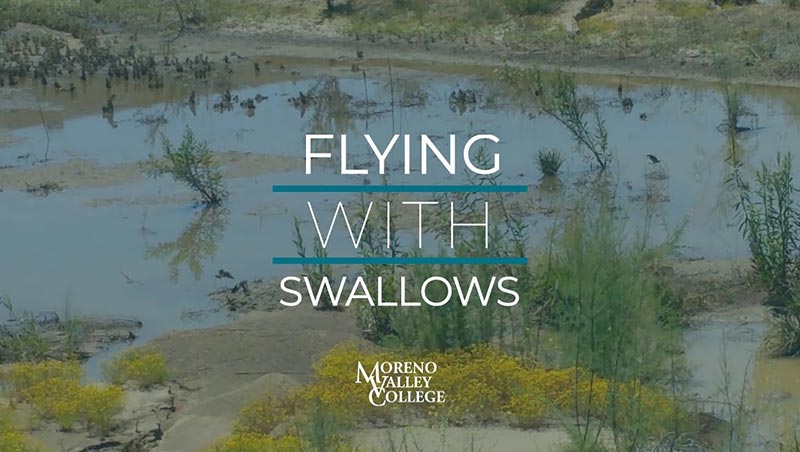
Research Papers and Posters
Participating students submitted research proposals and engaged in scientific experiments and observation along these inquiry lines. Below, you'll find a collection of research proposals and presentations demonstrating the exemplary work and observational skills of MVC's Biology students. All files listed are in PDF format and hosted on an external file repository.
Ecosystem Survey
Ecosystem Survey of MVC conducted by biology students includes two initiatives: “Who Lives Here” and “Adopt the Window.”
Monitoring fauna living around MVC is a long-term project conducted by Bio-12/61 (Introduction to Population and Organismal Biology) students. Every semester students deploy cameras in the college surroundings and at the Ben Clark Center. Scheduling deployments is a group effort to promote student collaboration and communication. Collected data is presented on MVC Fauna maps posted on ArcGIS online. Students are trained how use the ArcGIS software to enter their data. Geographic Information System software, ArcGIS, was donated to MVC by Esri (Environmental Systems Research Institute) in Redlands, California. The software is considered the most advanced GIS mapping software available. The best pictures from camera trapping are used to create a slide show of animals living around MVC.
Bio-61 students also prepare a one-page flyer about an animal or plant species that lives in the MVC area. The data include pictures of the species, its biology, recorded appearances (maps are preferred) and evaluation of the appearance in relation to local weather, pollution, urban developments, etc. The best handouts are presented to the college on the poster boards in Science and Technology Building and on the FWS website.
Interactive fauna maps by year (ArcGIS login required): 2018 | 2017 | Fall 2016 | Spring 2016 | Fall 2015 | Spring 2015
Bio-61 and Bio-1 students are assigned to specific windows where the cliff swallows build their nests. The assignment includes recording the history of nests he/she adopts on minimum weekly bases from the moment of construction or inhabitation to the end of the spring/summer course in the journal form. Project report should also contain photos, videos, samples collected around the nest such as feathers, pieces of nests, fresh droppings.
The entire MVC community has been invited to participate in this Adopt a Window initiative. All data is posted on ArcGIS annual Swallows maps. Future swallow observations will include local schools, buildings and bridges known to be inhabited by these birds.
Interactive nesting maps by year (ArcGIS login required): 2018 | 2017 | 2016 | 2015 | 2014
BIO-12/61 (spring) and BIO-1 (summer)
- Self-directed learning: observations to monitor the swallow population at the assigned location; data input on ArcGIS map; sample collection (feathers, droppings, fallen nests) from the assigned area.
- Team-based learning: camera trapping to monitor fauna in the MVC area; data input on ArcGIS map; periodic insect and other fauna related sample collection.
- Student driven problem-based approach – analysis of swallow population in relation to the weather and air pollution index; develop and modify protocols for data collection and area assignments; write research proposal for future project developments.
BIO-12/61 (fall)
- Self-directed learning: nest collection at the assigned location; observations on the nests infestation; update ArcGIS map.
- Team-based learning: camera trapping to monitor fauna in the MVC area; data input on ArcGIS map; periodic insect and other fauna related sample collection.
- Student driven problem-based approach – comparative analysis of swallows and other fauna populations at MVC over the years; write research proposal for future project.
Swallow Nesting Maps
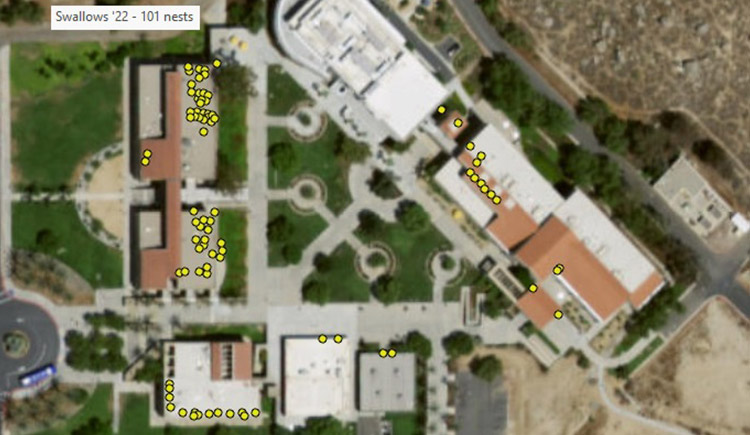
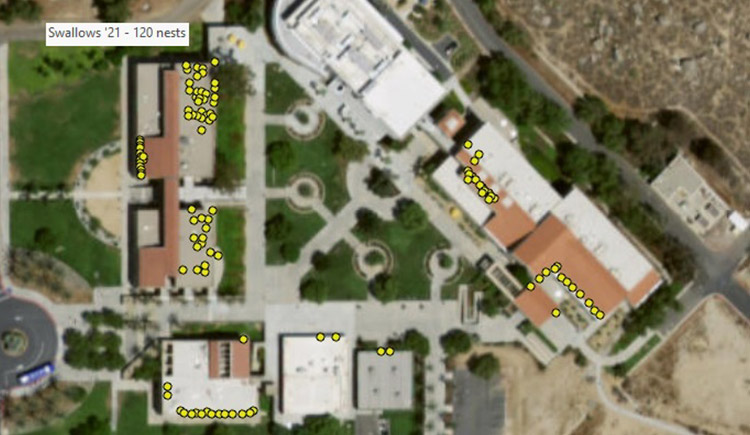
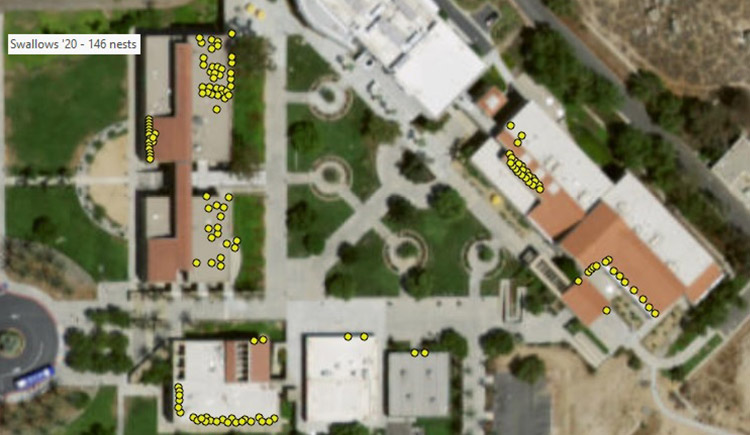
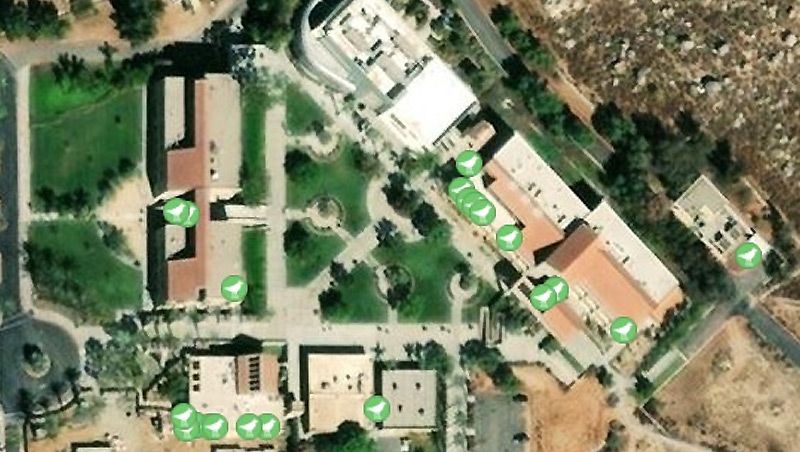
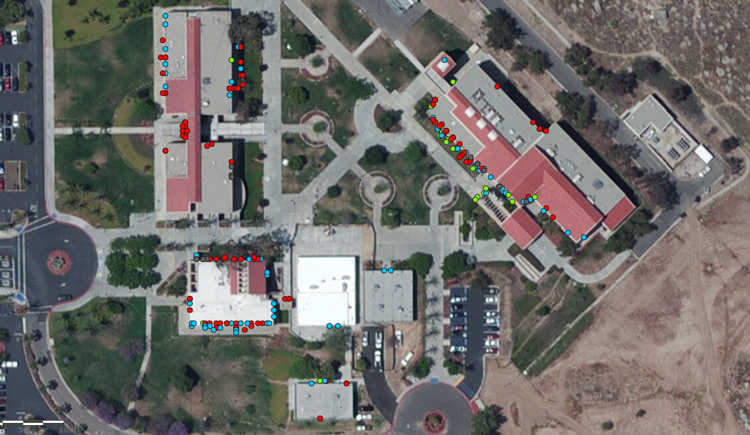
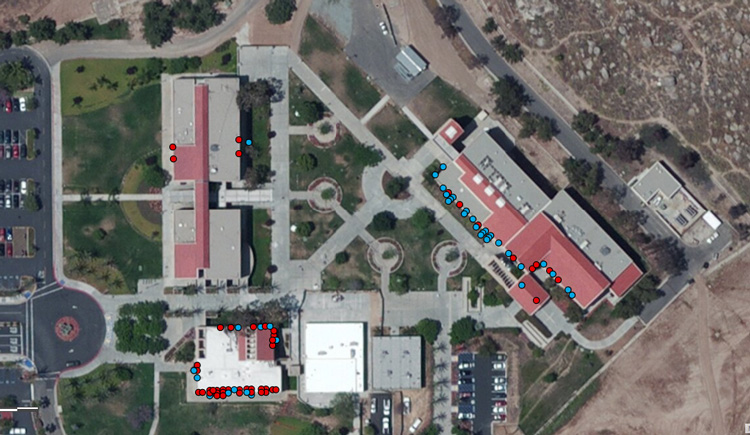
Ecosystem Investigation
Insect are identified by Bio-11/60 (Introduction to Molecular and Cell Biology) and Bio-60H students using modern DNA barcoding technique. Insect DNA is isolated using Qiagen’s Stool Isolation Kit. The samples are then subjected to PCR to amplify the targeted Catechol Oxidase 1 mitochondrial gene (658 bp) using Folmer primers. Purification of DNA from an agarose gel is performed using Qiagen’s Gel Purification Kit, and samples are sent for sequencing. The bioinformatics software, FinchTV, is used to visualize and clean the resulting chromatogram. The final trimmed sequence was input into NCBI's BLAST to identify insect species.
Insects identified by DNA barcoding that were found in stomachs of cliff swallows at Moreno Valley College, CA as of spring 2018 include:
Insect species identified in the MVC cliff swallow diet, fire ants, plant bugs and drywood termites, represent categories of insect with different importance to local environment. According to Purcell7 from University of California, Riverside (UCR), there are three fire ant species native to MVC area and one closely related species of invasive fire ants. Future studies in collaboration with Dr. Purcell will address the question if cliff swallows forage native or invasive species of fire ants. Plant bugs (piercing and sap sucking insects) are known insect pests, therefore elimination of these insects by swallows might benefit local agriculture. The western drywood termite is known as the single most damaging insect pest in the United Stated, their feeding habits having an estimated impact of $250 million per year in repairs to private and public structures in California and Arizona alone, cliff swallows may act as an effective natural deterrent to the economic impact of these pests. Cliff swallows are known to provide biological defense again other insect pests, such as mosquitoes.
Ecosystem Investigations accomplished by chemistry students included working on methods to measure water and soil contents used by swallows to build their nests. The resulting eight research laboratories support student inquiry and mastery of basic research laboratory skill sets. While the research goal for each is defined the students have control of how the method is applied. Critical thinking about experimental design is a key focus of this Chemistry program. The curriculum will be submitted to Chemical Education Exchange which has as a major emphasis to serve two-year college audiences in an interactive web platform. To learn more about FWS project Ecosystem Investigations, view the publication prepared by Diane Marsh, Ph.D., Professor Emeritus of Chemistry.
BIO-11/60 (spring/fall) and BIO-11H/60H (spring)
- Self-directed learning: DNA barcoding/metabarcoding to identify insects and other encountered species; build college data base using bioinformatic tools (BLAST, BOLD engines).
- Team-based learning: sample processing for pollution analysis in organic sample in collaboration with Chemistry students.
- Student driven problem-based approach – analysis of pollution and their effects on organisms on a molecular level; write research proposal for future project developments.
CHE-1A and 1AH
- Self-directed and team-based learning: analysis of local water and soil samples
- Student driven problem-based approach – developing methodology for chlorine and nitrate analysis in insects and bird droppings
CHE-1B and 1BH
- Self-directed and team-based learning: electrochemical analysis of ion concentration in local water and soil samples
- Student driven problem-based approach – developing methodology for heavy metal assessment such as mercury in insects and bird droppings.
Extracurricular Activities
FWS project creates multiple opportunities for students to broaden their involvement in research, for other disciplines to participate and build multidimensional initiative, and for college to become integrated under one common subject tapping the potential of all.
A total of 17 MVC FWS students conducted individual research during the length of the project, 2015-2018. The combined data from the individual research projects have been presented at conferences. In addition, the project initiated a partnership that was established between the MVC Student Employment Office and Student Financial Services that resulted in hiring two research students under the Federal Work Study program during the 2016-17 academic year. This collaboration is ongoing and will continue as a means for providing financial support, STEM work experience, and continuing individual undergraduate research projects for MVC students.
FWS incorporates a multidisciplinary approach to its undergraduate research. PI Joanna Werner-Fraczek, Ph.D. conducted a workshop on research-based learning to the MVC faculty during the college's faculty professional development, FLEX Days, in fall 2016. This generated interest in math, geography, computer science, Spanish and anthropology faculty who became interested in collaborating with the FWS project. Future projects have been developed, including engaging math students in statistical analysis in swallow's preferences for nest locations, and other projects detailed in this proposal. Spanish students already studied the symbolism of swallows in Latin literature and music. In spring 2018, anthropology students will study the presence and importance of swallows in Native American culture.
FWS sponsored three MVC Annual Swallow Day events. The 2017 Swallow Day included research poster presentations from science students participating in the project, and from Spanish students who presented posters on the importance of swallows in the Latin culture. The presentations were accompanied by Latin music included lyrics about swallows in relation to Latin culture. The purpose of the Annual Swallow Day was to increase college and community interest in swallows, increase awareness of our local swallow colonies, and initiate curiosity about how the continuing urbanization of our region impacts local swallow populations. The event also included student presentations and science seminar delivered by the guest speaker Nicolas Peterson from the California Wildlife Department. Nicolas Peterson discussed his agency's efforts to protect various wildlife species in the Riverside Region. More than 150 students and faculty members attended the event. In spring 2018 TED Talks speaker, Joseph Kerski, deliver a webinar on the role of GIS in today's world: Geotechnologies Essential for Learning, Vital for the Planet.
Collaboration with MVC's Library created a Swallow Literature Collection in 2016. The collection was expanded in 2017 to include publications related to the molecular biology research (DNA barcoding and primer designs.) Part of the research project in BIO-11H during spring 2017 included students establishing networks with researchers in the area to collect literature that enhanced the library collection.
Student research results (posters and flyers) have been presented to the college community on the display boards located in the Science and Technology building, and Honors launch.
Students and PI Werner-Fraczek presented the scientific results of the FWS project to the Riverside Community College District Board of Trustees three times over the course of the project. Twice the college website featured the "Who lives Here" slide shows that compiled selected photographs from the student-conducted camera trapping project.
The MVC community has been constantly updated on the developments and successes of the FWS project by media releases and college website.
Besides coursework assignments, students participating in the FWS project have multiple opportunities to visit and be involved in other initiatives. Since the beginning of the FWS project MVC students participated in:
- Urban Tree Project
- Global Bird Count Project
- UCR Botanical Gardens visits
- San Bernardino County Museum visits
- MVC's Swallow Club
- Swallow Day Events from 2015 - 2018
- USDA Protection of Tricolor Winged Blackbird Habitat
- USDA Native Plant Protection Project
- Earthwatch Resilient Tree Project
- Riverside Citizen Science
- USDA Fieldwork Study: Phacelia stellaris
The ultimate goal of FWS is to increase enrollment, retention, completion and transfer rates of students in STEM disciplines by engaging them in meaningful undergraduate research experiences. As such, FWS has actively conducted outreach to families and youth in Moreno Valley to educate them about STEM education and career opportunities, and disseminate the exciting research MVC students are conducting with the project. The Press Enterprise, the local newspaper for western Riverside County, published two articles featuring the project. Articles appeared both in print and in online outlets for the paper, which has a daily circulation of approximately 92,000. The project has its presence on the college website. The FWS has a permanent booth at the Welcome College Day, and the Senior Days organized by MVC for local high school students.
PI Werner-Fraczek visited Arizona Middle School in May 2017 where swallows also nest on school buildings. She spoke with students about the birds and about the MVC efforts to protect the swallows by studying about them. The visit concluded with a student walk to map nests.
In March 2017, PI Werner-Fraczek delivered a presentation about the research-based learning taking place at MVC under the FWS project to the US Department of Agriculture (USDA) field office in Riverside, CA. The presentation explained how MVC's collaboration with the Western Riverside County Region California Department of Fish and Wildlife has been strengthened by BIO-12 students participating in two projects. Students participated in Protection of Tricolor Winged Blackbird Habitat by planting rose bushes in the San Jacinto Wildlife Area. They also participated in the Native Plant Protection project by weeding designated plots in the Jurupa Park. The USDA recognized MVC's students by publishing an acknowledgment in the field office's monthly bulletin.
